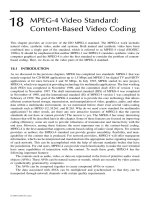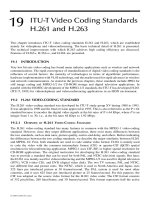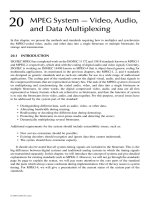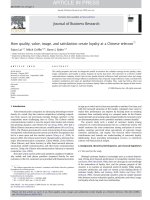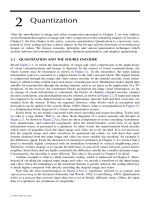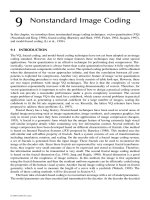Image and Videl Comoression P17
Bạn đang xem bản rút gọn của tài liệu. Xem và tải ngay bản đầy đủ của tài liệu tại đây (415.92 KB, 19 trang )
19
© 2000 by CRC Press LLC
ITU-T Video Coding Standards
H.261 and H.263
This chapter introduces ITU-T video coding standards H.261 and H.263, which are established
mainly for videophony and videoconferencing. The basic technical detail of H.261 is presented.
The technical improvements with which H.263 achieves high coding efficiency are discussed.
Features of H.263+, H.263++, and H.26L are presented.
19.1 INTRODUCTION
Very low bit rate video coding has found many industry applications such as wireless and network
communications. The rapid convergence of standardization of digital video-coding standards is the
reflection of several factors: the maturity of technologies in terms of algorithmic performance,
hardware implementation with VLSI technology, and the market need for rapid advances in wireless
and network communications. As stated in the previous chapters, these standards include JPEG for
still image coding and MPEG-1/2 for CD-ROM storage and digital television applications. In
parallel with the ISO/IEC development of the MPEG-1/2 standards, the ITU-T has developed H.261
(ITU-T, 1993) for videotelephony and videoconferencing applications in an ISDN environment.
19.2 H.261 VIDEO-CODING STANDARD
The H.261 video-coding standard was developed by ITU-T study group XV during 1988 to 1993.
It was adopted in 1990 and the final revision approved in 1993. This is also referred to as the P
¥
64
standard because it encodes the digital video signals at the bit rates of P
¥
64 Kbps, where
P
is an
integer from 1 to 30, i.e., at the bit rates 64 Kbps to 1.92 Mbps.
19.2.1 O
VERVIEW
OF
H.261 V
IDEO
-C
ODING
S
TANDARD
The H.261 video-coding standard has many features in common with the MPEG-1 video-coding
standard. However, since they target different applications, there exist many differences between
the two standards, such as data rates, picture quality, end-to-end delay, and others. Before indicating
the differences between the two coding standards, we describe the major similarity between H.261
and MPEG-1/2. First, both standards are used to code similar video format. H.261 is mainly used
to code the video with the common intermediate format (CIF) or quarter-CIF (QCIF) spatial
resolution for teleconferencing application. MPEG-1 uses CIF, SIF, or higher spatial resolution for
CD-ROM applications. The original motivation for developing the H.261 video-coding standard
was to provide a standard that can be used for both PAL and NTSC television signals. But later,
the H.261 was mainly used for videoconferencing and the MPEG-1/2 was used for digital television
(DTV), VCD (video CD), and DVD (digital video disk). The two TV systems, PAL and NTSC,
use different line and picture rates. The NTSC, which is used in North America and Japan, uses
525 lines per interlaced picture at 30 frames/second. The PAL system is used for most other
countries, and it uses 625 lines per interlaced picture at 25 frames/second. For this purpose, the
CIF was adopted as the source video format for the H.261 video coder. The CIF format consists
of 352 pixels/line, 288 lines/frame, and 30 frames/second. This format represents half the active
© 2000 by CRC Press LLC
lines of the PAL signal and the same picture rate of the NTSC signal. The PAL systems need only
perform a picture rate conversion and NTSC systems need only perform a line number conversion.
Color pictures consist of one luminance and two color-difference components (referred to as
Y
C
b
C
r
format) as specified by the CCIR601 standard. The
C
b
and
C
r
components are the half-size on
both horizontal and vertical directions and have 176 pixels/line and 144 lines/frame. The other
format, QCIF, is used for very low bit rate applications. The QCIF has half the number of pixels
and half the number of lines of CIF format. Second, the key coding algorithms of H.261 and
MPEG-1 are very similar. Both H.261 and MPEG-1 use DCT-based coding to remove intraframe
redundancy and motion compensation to remove interframe redundancy.
Now let us describe the main differences between the two coding standards with respect to
coding algorithms. The main differences include:
• H.261 uses only I- and P-macroblocks but no B-macroblocks, while MPEG-1 uses three
macroblock types, I-, P-, and B-macroblocks (I-macroblock is in intraframe-coded mac-
roblock, P-macroblock is a predictive-coded macroblock, and B-macroblock is a bidi-
rectionally coded macroblock), as well as three picture types, I-, P-, and B-pictures as
defined in Chapter 16 for the MPEG-1 standard.
• There is a constraint of H.261 that for every 132 interframe-coded macroblocks, which
corresponds to 4 GOBs (group of blocks) or to one-third of the CIF pictures, it requires
at least one intraframe-coded macroblock. To obtain better coding performance at low-
bit-rate applications, most encoding schemes of H.261 prefer not to use intraframe coding
on all the macroblocks of a picture, but only on a few macroblocks in every picture with
a rotational scheme. MPEG-1 uses the GOP (group of pictures) structure, where the size
of GOP (the distance between two I-pictures) is not specified.
• The end-to-end delay is not a critical issue for MPEG-1, but is critical for H.261. The
video encoder and video decoder delays of H.261 need to be known to allow audio
compensation delays to be fixed when H.261 is used in interactive applications. This
will allow lip synchronization to be maintained.
• The accuracy of motion compensation in MPEG-1 is up to a half-pixel, but is only a
full-pixel in H.261. However, H.261 uses a loop filter to smooth the previous frame. This
filter attempts to minimize the prediction error.
• In H.261, a fixed picture aspect ratio of 4:3 is used. In MPEG-1, several picture aspect
ratios can be used and the picture aspect ratio is defined in the picture header.
• Finally, in H.261, the encoded picture rate is restricted to allow up to three skipped
frames. This would allow the control mechanism in the encoder some flexibility to control
the encoded picture quality and satisfy the buffer regulation. Although MPEG-1 has no
restriction on skipped frames, the encoder usually does not perform frame skipping.
Rather, the syntax for B-frames is exploited, as B-frames require much fewer bits than
P-pictures.
19.2.2 T
ECHNICAL
D
ETAIL
OF
H.261
The key technologies used in the H.261 video-coding standard are the DCT and motion compen-
sation. The main components in the encoder include DCT, prediction, quantization (Q), inverse
DCT (IDCT), inverse quantization (IQ), loop filter, frame memory, variable-length coding, and
coding control unit. A typical encoder structure is shown in Figure 19.1.
The input video source is first converted to the CIF frame and then is stored in the frame memory.
The CIF frame is then partitioned into GOBs. The GOB contains 33 macroblocks, which are
1
/
12
of
a CIF picture or N of a QCIF picture. Each macroblock consists of six 8
¥
8 blocks among which
four are luminance (
Y
) blocks and two are chrominance blocks (one of
C
b
and one of
C
r
).
For the intraframe mode, each 8
¥
8 block is first transformed with DCT and then quantized.
The variable-length coding (VLC) is applied to the quantized DCT coefficients with a zigzag
scanning order such as in MPEG-1. The resulting bits are sent to the encoder buffer to form a
bitstream.
For the interframe-coding mode, frame prediction is performed with motion estimation in a
similar manner to that in MPEG-1, but only P-macroblocks and P-pictures, no B-macroblocks and
B-pictures, are used. Each 8
¥
8 block of differences or prediction residues is coded by the same
DCT coding path as for intraframe coding. In the motion-compensated predictive coding, the
encoder should perform the motion estimation with the reconstructed pictures instead of the original
video data, as it will be done in the decoder. Therefore, the IQ and IDCT blocks are included in
the motion compensation loop to reduce the error propagation drift. Since the VLC operation is
lossless, there is no need to include the VLC block in the motion compensation loop. The role of
the spatial filter is to minimize the prediction error by smoothing the previous frame that is used
for motion compensation.
The loop filter is a separable 2-D spatial filter that operates on an 8
¥
8 block. The corresponding
1-D filters are nonrecursive with coefficients , , . At block boundaries, the coefficients are 0,
1, 0 to avoid the taps falling outside the block. It should be noted that MPEG-1 uses subpixel
accurate motion vectors instead of a loop filter to smooth the anchor frame. The performance
comparison of two methods should be interesting.
The role of coding control includes the rate control, the buffer control, the quantization control,
and the frame rate control. These parameters are intimately related. The coding control is not the
part of the standard; however, it is an important part of the encoding process. For a given target
bit rate, the encoder has to control several parameters to reach the rate target and at the same time
provide reasonable coded picture quality.
Since H.261 is a predictive coder and the VLCs are used everywhere, such as coding quantized
DCT coefficients and motion vectors, a single transmission error may cause a loss of synchronization
and consequently cause problems for the reconstruction. To enhance the performance of the H.261
video coder in noisy environments, the transmitted bitstream of H.261 can optionally contain a
BCH (Bose, Chaudhuri, and Hocquengham) (511,493) forward error-correction code.
The H.261 video decoder performs the inverse operations of the encoder. After optional error
correction decoding, the compressed bitstream enters the decoder buffer and then is parsed by the
variable-length decoder (VLD). The output of the VLD is applied to the IQ and IDCT where the
data are converted to the values in the spatial domain. For the interframe-coding mode, the motion
FIGURE 19.1
Block diagram of a typical H.261 video encoder. (From ITU-T Recommendation H.261,
March 1993. With permission.)
1
4
§
1
2
§
1
4
§
© 2000 by CRC Press LLC
© 2000 by CRC Press LLC
compensation is performed and the data from the macroblocks in the anchor frame are added to
the current data to form the reconstructed data.
19.2.3 S
YNTAX
D
ESCRIPTION
The syntax of H.261 video coding has a hierarchical layered structure. From the top to the bottom
the layers are picture layer, GOB layer, macroblock layer, and block layer.
19.2.3.1 Picture Layer
The picture layer begins with a 20-bit picture start code (PSC). Following the PSC, there are
temporal reference (5-bit), picture type information (PTYPE, 6-bit), extra insertion information
(PEI, 1-bit), and spare information (PSPARE). Then the data for GOBs are followed.
19.2.3.2 GOB Layer
A GOB corresponds to 176 pixels by 48 lines of
Y
and 88 pixels by 24 lines of
C
b
and
C
r
. The
GOB layer contains the following data in order: 16-bit GOB start code (GBSC), 4-bit group number
(GN), 5-bit quantization information (GQUANT), 1-bit extra insertion information (GEI), and spare
information (GSPARE). The number of bits for GSPARE is variable depending on the set of GEI
bits. If GEI is set to “1,” then 9 bits follow, consisting of 8 bits of data and another GEI bit to
indicate whether a further 9 bits follow, and so on. Data of the GOB header are then followed by
data for macroblocks.
19.2.3.3 Macroblock Layer
Each GOB contains 33 macroblocks, which are arranged as in Figure 19.2. A macroblock consists
of 16 pixels by 16 lines of
Y
that spatially correspond to 8 pixels by 8 lines each of
C
b
and
C
r
.
Data in the bitstream for a macroblock consist of a macroblock header followed by data for blocks.
The macroblock header may include macroblock address (MBA) (variable length), type information
(MTYPE) (variable length), quantizer (MQUANT) (5 bits), motion vector data (MVD) (variable
length), and coded block pattern (CBP) (variable length). The MBA information is always present
and is coded by VLC. The VLC table for macroblock addressing is shown in Table 19.1. The
presence of other items depends on macroblock type information, which is shown in the VLC
Table 19.2.
19.2.3.4 Block Layer
Data in the block layer consists of the transformed coefficients followed by an end of block (EOB)
marker (10 bits). The data of transform coefficients (TCOEFF) is first converted to the pairs of
RUN and LEVEL according to the zigzag scanning order. The RUN represents the number of
successive zeros and the LEVEL represents the value of nonzero coefficients. The pairs of RUN
and LEVEL are then encoded with VLCs. The DC coefficient of an intrablock is coded by a fixed-
length code with 8 bits. All VLC tables can be found in the standard document (ITU-T, 1993).
FIGURE 19.2
Arrangement of macroblocks in a GOB. (From ITU-T Recommendation H.261, March 1993.
With permission.)
© 2000 by CRC Press LLC
19.3 H.263 VIDEO-CODING STANDARD
The H.263 video-coding standard (ITU-T, 1996) is specifically designed for very low bit rate
applications such as practical video telecommunication. Its technical content was completed in late
1995 and the standard was approved in early 1996.
19.3.1 O
VERVIEW
OF
H.263 V
IDEO
C
ODING
The basic configuration of the video source coding algorithm of H.263 is based on the H.261.
Several important features that are different from H.261 include the following new options: unre-
stricted motion vectors, syntax-based arithmetic coding, advanced prediction, and PB-frames. All
these features can be used together or separately for improving the coding efficiency. The H.263
TABLE 19.1
VLC Table for Macroblock Addressing
MBA Code MBA Code MBA Code
1 1 13 0000 1000 25 0000 0100 000
2 011 14 0000 0111 26 0000 0011 111
3 010 15 0000 0110 27 0000 0011 110
4 0011 16 0000 0101 11 28 0000 0011 101
5 0010 17 0000 0101 10 29 0000 0011 100
6 0001 1 18 0000 0101 01 30 0000 0011 011
7 0001 0 19 0000 0101 00 31 0000 0011 010
8 0000 111 20 0000 0100 11 32 0000 0011 001
9 0000 110 21 0000 0100 10 33 0000 0011 000
10 0000 1011 22 0000 0100 011 MBA stuffing 0000 0001 111
11 0000 1010 23 0000 0100 010 Start code 0000 0000 0000 0001
12 0000 1001 24 0000 0100 001
TABLE 19.2
VLC Table for Macroblock Type
Prediction MQUANT MVD CBP TCOEFF VLC
Intra x 0001
Intra x x 0000 001
Inter x x 1
Inter x x x 0000 1
Inter+MC x 0000 0000 1
Inter+MC x x x 0000 0001
Inter+MC x x x x 0000 0000 01
Inter+MC+FIL x 001
Inter+MC+FIL x x x 01
Inter+MC+FIL x x x x 0000 01
Notes:
1. “x” means that the item is present in the macroblock,
2. It is possible to apply the filter in a non-motion-compensated macroblock
by declaring it as MC+FIL but with a zero vector.
© 2000 by CRC Press LLC
video standard can be used for both 625-line and 525-line television standards. The source coder
operates on the noninterlaced pictures at picture rate about 30 pictures/second. The pictures are
coded as luminance and two color difference components (
Y
,
C
b
, and
C
r
). The source coder is based
on a CIF. Actually, there are five standardized formats which include sub-QCIF, QCIF, CIF, 4CIF,
and 16CIF. The detail of formats is shown in Table 19.3.
It is noted that for each format, the chrominance is a quarter the size of the luminance picture,
i.e., the chrominance pictures are half the size of the luminance picture in both horizontal and
vertical directions. This is defined by the ITU-R 601 format. For CIF format, the number of
pixels/line is compatible with sampling the active portion of the luminance and color difference
signals from a 525- or 626-line source at 6.75 and 3.375 MHz, respectively. These frequencies have
a simple relationship to those defined by the ITU-R 601 format.
19.3.2 T
ECHNICAL
F
EATURES
OF
H.263
The H.263 encoder structure is similar to the H.261 encoder with the exception that there is no
loop filter in H.263 encoder. The main components of the encoder include block transform, motion-
compensated prediction, block quantization, and VLC. Each picture is partitioned into groups of
blocks, which are referred to as GOBs. A GOB contains a multiple number of 16 lines,
k
*
16
lines, depending on the picture format (
k
= 1 for sub-QCIF, QCIF;
k
= 2 for 4CIF;
k
= 4 for 16CIF).
Each GOB is divided into macroblocks that are the same as in H.261 and each macroblock consists
of four 8
¥
8 luminance blocks and two 8
¥
8 chrominance blocks. Compared with H.261, H.263
has several new technical features for the enhancement of coding efficiency for very low bit rate
applications. These new features include picture-extrapolating motion vectors (or unrestricted
motion vector mode), motion compensation with half-pixel accuracy, advanced prediction (which
includes variable-block-size motion compensation and overlapped block motion compensation),
syntax-based arithmetic coding, and PB-frame mode.
19.3.2.1 Half-Pixel Accuracy
In H.263 video coding, half-pixel accuracy motion compensation is used. The half-pixel values are
found using bilinear interpolation as shown in Figure 19.3.
Note that H.263 uses subpixel accuracy for motion compensation instead of using a loop filter
to smooth the anchor frames as in H.261. This is also done in other coding standards, such as
MPEG-1 and MPEG-2, which also use half-pixel accuracy for motion compensation. In MPEG-4
video, quarter-pixel accuracy for motion compensation has been adopted as a tool for version 2.
19.3.2.2 Unrestricted Motion Vector Mode
Usually motion vectors are limited within the coded picture area of anchor frames. In the unrestricted
motion vector mode, the motion vectors are allowed to point outside the pictures. When the values
TABLE 19.3
Number of Pixels per Line and the Number of Lines for Each Picture Format
Picture
Format
Number of Pixels
for Luminance (
dx
)
Number of Lines
for Luminance (
dy
)
Number of Pixels
for Chrominance (
dx
/2)
Number of Lines
for Chrominance (
dy
/2)
Sub-QCIF 128 96 64 48
QCIF 176 144 88 72
CIF 352 288 176 144
4CIF 704 576 352 288
16CIF 1408 1152 704 576
© 2000 by CRC Press LLC
of the motion vectors exceed the boundary of the anchor frame in the unrestricted motion vector
mode, the picture-extrapolating method is used. The values of reference pixels outside the picture
boundary will take the values of boundary pixels. The extension of the motion vector range is also
applied to the unrestricted motion vector mode. In the default prediction mode, the motion vectors
are restricted to the range of [–16, 15.5]. In the unrestricted mode, the maximum range for motion
vectors is extended to [–31.5, 31.5] under certain conditions.
19.3.2.3 Advanced Prediction Mode
Generally, the decoder will accept no more than one motion vector per macroblock for baseline
algorithm of H.263 video-coding standard. However, in the advanced prediction mode, the syntax
allows up to four motion vectors to be used per macroblock. The decision to use one or four vectors
is indicated by the macroblock type and coded block pattern for chrominance (MCBPC) codeword
for each macroblock. How to make this decision is the task of the encoding process.
The following example gives the steps of motion estimation and coding mode selection for the
advanced prediction mode in the encoder.
Step 1. Integer pixel motion estimation:
(19.1)
where
SAD
is the sum of absolute difference, values of (
x
,
y
) are within the search
range,
N
is equal to 16 for 16
¥
16 block, and
N
is equal to 8 for 8
¥
8 block.
(19.2)
(19.3)
Step 2. Intra/intermode decision:
If
A
< (
SAD
inter
– 500), this macroblock is coded as intra-MB; otherwise, it is coded
as inter-MB, where
SAD
inter
is determined in step 1, and
(19.4)
FIGURE 19.3
Half-pixel prediction by bilinear interpolation.
SAD x y original
N
j
N
i
N
,,
()
=-
=
-
=
-
ÂÂ
previous
0
1
0
1
SAD SAD x y
48 8¥
=
()
Â
,
SAD SAD x y SAD
inter
=
()
()
¥
min , , .
16
48
AMB
mean
ji
==
==
ÂÂ
original
0
15
0
15

